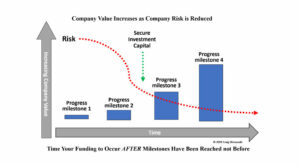 Most technically-oriented individuals believe that once their beloved product, (which is of great technical value) reaches commercialization, multitudes will clamor to buy their product or service. This nearsighted condition is termed “entrepreneurial myopia”. It is an ocular disease notorious for destroying promising enterprises. Entrepreneurial myopia is highly contagious, and the individuals most susceptible to this debilitating condition are typically those employed within the same organization. Rest assured, all others are immune to this disease, most notably those that hold the investment capital you seek; also, potential customers with cash in their wallet. These groups are immune because their eyesight and peripheral vision is unimpeded by bias and they clearly see what those with this disease cannot.
Most technically-oriented individuals believe that once their beloved product, (which is of great technical value) reaches commercialization, multitudes will clamor to buy their product or service. This nearsighted condition is termed “entrepreneurial myopia”. It is an ocular disease notorious for destroying promising enterprises. Entrepreneurial myopia is highly contagious, and the individuals most susceptible to this debilitating condition are typically those employed within the same organization. Rest assured, all others are immune to this disease, most notably those that hold the investment capital you seek; also, potential customers with cash in their wallet. These groups are immune because their eyesight and peripheral vision is unimpeded by bias and they clearly see what those with this disease cannot.
No organization can thrive — even with commercialized products — without understanding and correctly applying the fundamental tools of effective marketing. To prevent this potentially fatal entrepreneurial myopia it is important to understand the following four aspects when marketing your product or service.
1. Your Market is Not as Homogeneous as You Think
Individuals with similar demographic characteristics (e.g. age, gender, locale, etc) do not have the same needs, wants and desires. For instance, all 55-year-old males residing in California do not desire the same type of car, nor enjoy similar hobbies, nor suffer from identical medical conditions. Marketing a product simply using demographic characteristics is neither efficient nor effective. Companies rapidly burn through enormous amounts of capital when marketing to “potential” customers based upon demographics alone. Successful enterprises know that their true market are individuals with similar unmet needs, wants, and desires that their product or service fulfills. They characterize their target market by identifying combinations of narrowing demographic characteristics, which only serve as a surrogate for the real metric. Once they identify this group, they can target them effectively. Biomedical products are unique in that their usage decisions are collectively made by three separate entities: the Patient, Physician, and Payor — each of these are intersecting customers. For biomedical products, marketing success is found in understanding the needs of all three customers.
Marketing principles and tools are universal to all products. So what distinguishes successful marketing strategies from ineffective ones? It is the correct application and usage of marketing tools when developing a marketing strategy. For example, one can use a crescent wrench to drive nails into a wood frame when building a house. Although this works, a carpenter will have better results when using a hammer. The best marketing strategies correctly apply the proper marketing tools to identify a target market and then position the product properly to meet the target market’s unfulfilled needs. To learn more about how to develop a marketing strategy, the book, The Business of Bioscience, describes this in more detail, taking the reader through a stepwise process using two biotechnology product examples.
2. Successful Products Satisfy Significant Needs that are Unmet for a Core Group of People
Since your product will be marketed to a particular group based upon their unfulfilled needs, wants and desires, the better that your product fulfills these unmet needs, wants or desires, the better your product will be accepted by this target market. When developing any product, always conceive and develop products that fulfill and satisfy truly unmet needs of a core group of individuals. You cannot know the nuances of customer needs if you never leave your garage, office or laboratory. The only way you will really understand these needs is by constant customer interaction. Any systematic learning from potential customers is termed primary market research. Secondary market research consists of studies and results produced by others about your customers. Good market research is a vital part of developing any successful marketing strategy.
Many organizations claim to be either market-driven or technology-driven. I liken this comment to a Socrates quote, “Thou shouldst eat to live; not live to eat”. Clearly, there is a finer point to this saying, but that aside, if you don’t eat – you won’t live. Conversely, if you are not alive – you won’t be eating. Living and eating are not mutually exclusive activities. Successful companies are inherently technology and market driven. Nevertheless, do not forget that no matter how technically innovative a product, its value proposition is not the technology but rather the unmet need that your product fills in spite of competition (see 9/18/09 post “Selling Science: Where’s the Value Proposition?).
3. You Must First Reach and Own Your Niche
Most enterprises want to reach the masses with their product. This is an wonderful goal, but do not begin by marketing your product to the masses — reach the early adopters first. Early adopters are individuals who love your product and enjoy using it because of its profound benefits, and require very little effort to get them to purchase. They quickly adopt your product without much effort because they were awaiting its commercialization. After you own this niche, then you can more effectively reach the early majority. Nike began by owning the long-distance running shoe market, then expanded to all types of athletic shoes, then moved to other athletic gear. They became successful by owning their niche first. For those that want to understand more about the characteristics of the technology adoption curve, read Geoffrey Moore’s book Crossing the Chasm.
4. Marketing is Not Selling
Marketing is not the same as selling. Selling is a natural result of effective marketing. As companies grow in size, they typically separate Sales departments from Marketing departments. Functional separation for management and accounting purposes is reasonable, but when these groups become semi-independent vs. interdependent, revenues suffer. Sales and marketing both require specialized efforts. Though they are not the same, they are a continuum of the same activity. Successful marketing is not a form of manipulation or coercion for customers to like, use or buy your product. Successful marketing is simply finding the most effective path to your target market customers with a product that is valuable and effective for their specific needs.
The Takeaway Tidbit: What is the Treatment for Entrepreneurial Myopia?
Administer a heavy dose of marketing strategy, coupled with a sustained course of customer interaction, followed by multiple doses of primary and secondary market research. This prescription works best as a prophylactic (before reaching commercialization), but it does cure the acute condition – only if the patient (organization) does not run out of cash before the course of treatment is completed.
Copyright 2015 © BioSource Consulting. All Rights Reserved







